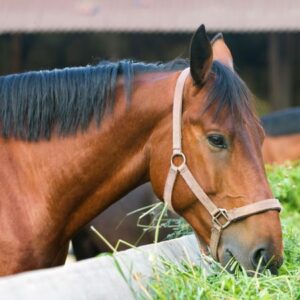 Experts suggest that feeding alfalfa (lucerne) reduces the incidence and severity of gastric ulcers in the upper region of the stomach, known also as an equine squamous gastric disease. The buffering capacity of alfalfa hay is documented well. However, new research suggests that to maintain a healthy gastric environment, horses need more than alfalfa.
Experts suggest that feeding alfalfa (lucerne) reduces the incidence and severity of gastric ulcers in the upper region of the stomach, known also as an equine squamous gastric disease. The buffering capacity of alfalfa hay is documented well. However, new research suggests that to maintain a healthy gastric environment, horses need more than alfalfa.
What is a healthy gastric environment?
In certain circumstances, the pH of the stomach can dip as low as 1 or 2, on the pH scale of 0 to 14, which is more acidic than grapefruit or tomato juice. The lower or glandular region of the stomach produces mucus to protect the lining. The upper or squamous region, however, is far more sensitive to sloshing acid, making it prone to ulceration. All horses are at risk of developing gastric ulcers, but horses involved in training and competition have a higher prevalence.
Recognizing the widespread welfare and economic effects of equine gastric ulcer syndrome (EGUS), Kentucky Equine Research developed several products to support stomach health. “Some of these products contain ingredients that neutralize excessive gastric acid. This protects the stomach lining by reducing acidity and providing a physical barrier due to coating properties.,” said Catherine Whitehouse, M.S., a nutritionist for Kentucky Equine Research.
Altering the diet may also minimize EGUS. Nutritionists suggest:
- Feeding diets high in fiber (at least 1.5% body weight in forage);
- Offering stabilized rice bran or vegetable oil rather than high-starch feedstuffs for supplemental energy;
- Feeding several meals per day when possible; and
- Using small-hole hay nets and slow feeders to make forage last through the night until breakfast.
Nutritionists sometimes recommend feeding alfalfa hay to help ward off EGUS. High levels of certain nutrients, including protein and calcium, reportedly help neutralize the acid in the stomach.
According to Whitehouse, “The amount of calcium in alfalfa hay is greater than 1% with a calcium-to-phosphorus ratio ranging from 3:1-6:1. Calcium in grass hay hovers around half that with a much tighter calcium-to-phosphorus ratio.”
Pure alfalfa hay is usually reserved for horses with high nutritional needs, as it would oversupply energy, protein, and minerals for many horses. “We including only a portion of alfalfa in the diet and combining it with high-quality grass hay,” advised Whitehouse.
Alfalfa pellets versus Alfalfa hay
Recent studies suggest alfalfa pellets do not buffer the stomach in heavily exercised horses as effectively as alfalfa hay. The study, performed in France, included 80 trotters from four training centers randomly divided into two groups. Horses in the control group were fed their usual diet of free-choice grass hay and pelleted concentrate. This provided 4.5 ± 1.5 g of starch per kilogram body weight per day. In the alfalfa group, the diet was the same except half of the pelleted concentrate was replaced with dehydrated alfalfa pellets, providing only 2.3 ± 0.7 g of starch per kilogram body weight per day.
A gastroscopy directly visualized the stomach lining of all horses. Days 0, 21, and 42 assigned ulcer scores based on a 0 to 4 scale, with 4 denoting severe ulceration. Throughout the study period, there were no other changes in management or training.
At baseline (day 0), 49 of the 80 (61%) horses had either no lesions or mild ulcerations, equivalent to an EGUS score of 0, 1, or 2. The remaining 31 horses (39%) had severe EGUS with scores of 3 and 4. On days 21 and 42, no significant effect of the diet on either healing or prevention of EGUS was detected.
Researchers theorized that alfalfa pellets did not provide a protective layer on top of the gastric contents. Alfalfa hay or chaff prevents splashing of acidic gastric contents on the sensitive squamous stomach lining. Giving alfalfa hay or chaff before exercise will help buffer the acid and prevent damaging acid splash in the stomach. Additional protection may be provided by adding a research-proven gastric buffer, such as Triacton, to a small meal 30 minutes before work.
Sources
*Julliand, S., M. Buttet, T. Hermange, and V. Julliand. 2021. Effect of replacing part of concentrates with pelleted alfalfa on squamous gastric ulcers in exercised trotters. Journal of Equine Veterinary Science 10:103556.
The original article can be found at Kentucky Equine Research.
